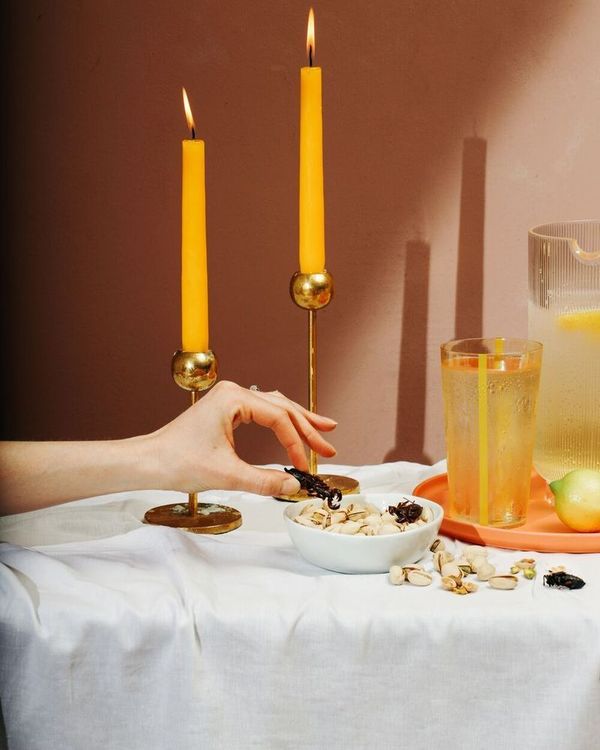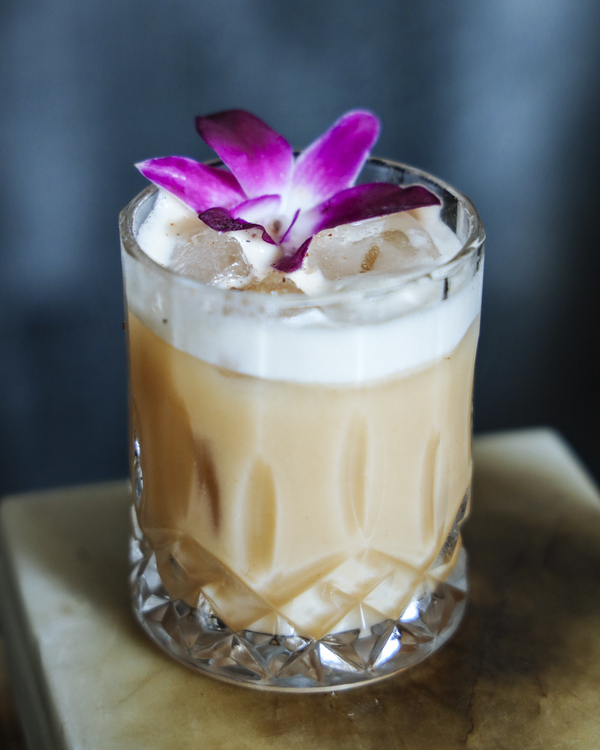Bugging Out with Insect-Flavored Cocktails
/Photo by Jennifer Chase.
By Tim Ebner, photography by Jennifer Chase
“You ate what?” “I would never …” “Ewww, gross!”
These are just a few of the responses I typically get when I tell people that I love to eat bugs.
While you might consider grasshoppers, crickets, ants or worms to be common household pests, many people around the world have developed a taste for edible insects.
When cooked and seasoned carefully, bugs exhibit extreme earthy and bold flavors. Sometimes there’s even a lingering taste of the land from which they came—dare I call it terroir?
Bugs are increasingly becoming an essential part of the human dietary habit. Already people in more than 130 countries eat insects often as part of a meal, and anyone who’s traveled to Mexico knows that chapulines (grasshoppers) are considered to be a delicacy and Oaxacans anticipate griddling up flying ants, called chicatanas, every spring when they swarm after the first rains.
In Washington, DC, bugs are also increasingly showing up on food and drink menus, especially at Mexican-themed eateries, like Oyamel, Poca Madre and Tequila y Mezcal. At these restaurants, especially behind the bar, insects take on a life of their own—an essential ingredient that can add new flavor dimensions to a summer cocktail.
Hibiscus Margarita with Sal de Gusano
Photo by Jennifer Chase.
Columbia Heights has a new mezcal bar called Tequila y Mezcal and it opened just in time for summer, serving Oaxacan dishes as well as tacos and cocktails inspired by century-old cooking traditions.
On most nights, the husband-and-wife team of Chefs Dio Montero and Mirna Alvarado (of Taqueria Habanero fame—also in Columbia Heights) oversee a rapid-fire production of tacos on the grill, including one off-menu item, grasshopper tacos, that only in-the-know patrons know to order a la carte.
Especially in the south-central regions of Mexico, all sorts of bugs, including worms, are eaten regularly. As larvae, they become a tasty byproduct known as sal de gusano (worm salt), which for many in Mexico is a prized possession. You might see it as an additive to a sauté or folded into the making of hand-pressed tortillas. It’s also served in a small bowl alongside a sip of mezcal—just pinch some of the salt to taste, then sip slowly on the mezcal for a smoky aftereffect, says William Martinez, general manager of Tequila y Mezcal.
“You can taste the slight saltiness and you can taste the roasted flavor too,” Martinez says. “I would say it’s almost like eating a sunflower seed as a bar snack.”
Worm salt is also a sustainable way to help mezcal and tequila producers. That’s because this bug’s larvae typically feast on the roots of the agave plant, and since Aztec civilization people have hand-picked the pest to save the agave. When cooked and roasted using a comal, the larvae plump up into a protein-laden snack, or can be ground and combined with rock salt and dried chile peppers to make sal de gusano.
For the at-home bartender, worm salt is an excellent flavoring agent that can be used to replace plain old salt for margaritas. Bartender Israel Mendez shares a recipe that calls for mezcal and comes spiked with the tart and floral notes of hibiscus. To find a jar of sal de gusano, he suggests importing it directly from Oaxaca (a few companies on Amazon.com import the salt) or check your local organic or Mexican market.
Cocktail ingredients:
2 ounces Wahaka Joven Espadin Mezcal
1 ounce lime juice
1 ounce hibiscus simple syrup
1 cup dried hibiscus flowers (for simple syrup and garnish)
Lime wedge (for garnish)
Sal de gusano (for garnish)
To make the hibiscus simple syrup: Bring 2 cups of sugar and water in a saucepan to boil, stirring occasionally. Remove the saucepan from heat, then add a cup of hibiscus flowers, allowing the mixture to steep for at least 5 to 10 minutes and continuing to stir occasionally. Strain the mixture, keeping only the simple syrup.
To make the hibiscus margarita: In a cocktail shaker with ice, combine the mezcal, lime juice and hibiscus simple syrup. Shake vigorously. Take a cocktail glass and dip the rim in lime juice, then onto a plate of sal de gusano. Finally, take the glass and add ice (half-full), then strain the cocktail mix, garnishing with a lime wedge or slice and a dried hibiscus flower.
Oaxacan Orange with Gusano Rojo
Photo by Jennifer Chase.
Gusano rojo (not to be confused with a popular Mexican brand of mezcal) literally translates to mean “red worm,” and it’s another inventive take on a worm salt that adds spice and heat to a cocktail that’s bursting with fresh citrus flavor—the Oaxacan Orange.
The cocktail is a specialty at Oyamel in Chinatown. Beverage director Alan Grublauskas says it’s one of the most popular drinks on the menu, and he bets very few people know the drink comes lined with the restaurant’s house-made worm salt, ground with Oaxacan sea salt, chile de árbol pepper and a common Mexican spice, Pasilla de Oaxaca Flakes.
“Then we add the red worms—gusano rojo—to bring out the orange color in the salt,” he says.
His fondness for bugs doesn’t stop there.
“We typically like to ask people how adventurous they are,” Grublauskas says. “Because, here, you can sample everything from worms to scorpions, even grasshoppers.”
Aside from the sustainability benefits of eating insects, Grublauskas likens the taste to eating potato chips, but better.
“You can roast this bug in a mixture of salt and spices, and it really transforms into something extremely tasty. I think many people’s minds are shifting, and they’re venturing toward insects,” he says. “You can eat them whole or you can grind them down into a variety of different salts that work really well as a garnish or finish.”
Cocktail ingredients:
1½ ounces Wahaka Joven Espadin Mezcal
½ ounce Luxardo Maraschino liqueur
2 ounces sour orange juice
Gusano rojo (for garnish)
Orange wedge (for garnish)
Sour orange juice ingredients:
¼ cup fresh-squeezed grapefruit juice
¼ cup fresh-squeezed orange juice
½ cup fresh lime juice
In a cocktail shaker with ice, combine the mezcal, Luxardo and sour orange juice. Shake vigorously. Take a cocktail glass and first dip the rim in lime juice followed by gusano rojo. Finally, take the glass and add ice (half-full), then strain the mix, adding an orange wedge (rim dipped in extra gusano rojo) if you prefer.
Charlie and the Chapuline Factory
Photo by Jennifer Chase.
With a cocktail named in honor of Willy Wonka, you would expect a drink that’s outlandish and fun.
But without looking too closely at the cocktail menu, Poca Madre patrons could soon be in for a sudden surprise if they order the Charlie and the Chapuline Factory.
The drink comes garnished with a grasshopper and combines the earthy flavors of ground-up peanuts and grasshoppers for an earthy sensation.
“We blend up the grasshoppers with our peanut syrup. Then we purée and strain it,” says Amin Seddiq, Poca Madre's beverage manager. “You get this distinct earthy flavor, with a slight saltiness, because the grasshoppers are cured in salt and lime.”
The drink is a classic take on a sour cocktail, but it has both thickness and texture thanks to the peanut-and-grasshopper syrup.
And if you think grasshoppers are still somewhat of a novelty in the United States, you better guess again.
Seddiq says recently these critters have sprung onto grocery store shelves, including at MOM’s Organic Market in Ivy City.
Preserved insects, like grasshoppers, crickets and mealworms, are for sale by the ounce, or you can try a variety of pre-packaged snack bars and chips seasoned with insect powder.
“I think grasshoppers really are one of nature’s original proteins,” Seddiq says. “So many cultures have used them for centuries, and it adds such an interesting flavor component to the drink.”
Cocktail ingredients:
2 ounces mezcal
1 ounce lime juice
1½ ounces peanut syrup
Egg white from 1 egg
Peanut and grasshopper syrup:
3 ounces peanuts
¼ ounce grasshoppers
1 cup sugar
1½ cups pineapple juice
1 stalk lemon grass, roughly chopped
1 chile de árbol pepper, roughly chopped
To make the peanut syrup: Wrap the lemongrass and chilies in cheesecloth. In a saucepan, bring the sugar, grasshoppers and pineapple juice to a boil. Then, add in the lemongrass and chilies and let steep for 10 minutes on high heat. Remove the lemongrass and chilies, then blend the remaining liquid on high for 2 minutes. Strain the mixture and place back into the blender, adding peanuts. Blend for another 2 minutes. Place the mixture back in the saucepan and bring it to a boil again. Turn off the heat and let simmer for 15 minutes. Finally, strain a final time, adding a quarter cup of pineapple juice.
To make the Charlie and the Chapuline Factory: In a cocktail shaker combine all ingredients, then shake vigorously. Strain and serve the drink in a cocktail glass on the rocks. Garnish with an edible flower and place a grasshopper on the flower.








